
Helsinki is the capital and most populous city in Finland. It is located on the shore of the Gulf of Finland and serves as the seat of the Uusimaa region in southern Finland. Approximately 0.67 million people live in the municipality, with 1.25 million in the capital region, and 1.58 million in the metropolitan area. As the most populous urban area in Finland, it is the country's most significant centre for politics, education, finance, culture, and research. Helsinki is situated 80 kilometres (50 mi) to the north of Tallinn, Estonia, 360 kilometres (220 mi) to the north of Riga, Latvia, 400 kilometres (250 mi) to the east of Stockholm, Sweden, and 300 kilometres (190 mi) to the west of Saint Petersburg, Russia. Helsinki has significant historical connections with these four cities.
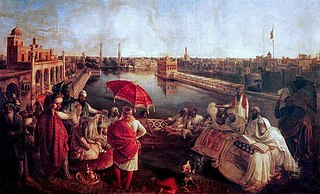
Sikhs are an ethnoreligious group who adhere to Sikhism, an Indian religion that originated in the late 15th century in the Punjab region of the Indian subcontinent, based on the revelation of Guru Nanak. The term Sikh has its origin in the Sanskrit word śiṣya, meaning 'seeker', 'disciple' or 'student'. According to Article I of Chapter 1 of the Sikh Rehat Maryada, the definition of Sikh is: Any human being who faithfully believes in
- One Immortal Being
- Ten Gurus, from Guru Nanak Sahib to Guru Gobind Singh Sahib
- The Guru Granth Sahib
- The utterances and teachings of the ten Gurus and
- The baptism bequeathed by the tenth Guru and who does not owe allegiance to any other religion, is a Sikh.

Vantaa is a city in Finland. It is located to the north of the capital, Helsinki, in southern Uusimaa. The population of Vantaa is approximately 247,000. It is the 4th most populous municipality in Finland. Vantaa is part of the Helsinki Metropolitan Area, which has approximately 1.58 million inhabitants.

Helsinki-Vantaa Airport, or simply Helsinki Airport, is the main international airport of the city of Helsinki, its surrounding metropolitan area, and the Uusimaa region in Finland. The airport is located in the neighbouring city of Vantaa, about 5 kilometres (3 mi) west of Tikkurila, the administrative centre of Vantaa and 9.2 NM north of Helsinki's city centre. The airport is operated by state-owned Finavia. The facility covers a total of 1,800 hectares of land and contains three runways.
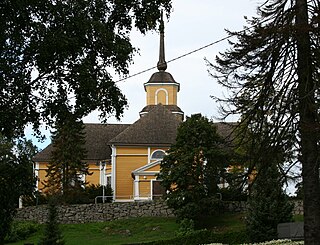
Nurmijärvi is a municipality in Finland, located in the southern interior of the country. Nurmijärvi is situated in the Uusimaa region. The population of Nurmijärvi is approximately 45,000. It is the 26th most populous municipality in Finland and the most populous municipality without city status. Nurmijärvi is part of the Helsinki Metropolitan Area, which has approximately 1.58 million inhabitants.
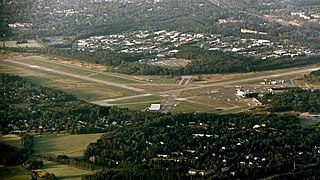
Helsinki-Malmi Airport(IATA: HEM, ICAO: EFHF) was an airfield in Helsinki, Finland, located in the district of Malmi, 5.4 NM north-north-east of the city centre. It was opened in 1936. Until the opening of Helsinki-Vantaa Airport in 1952, it was the main airport of Helsinki and of Finland. After that, it was used for general aviation and flight training, and remained the second-busiest airport in Finland, as measured by the number of landings, after Helsinki-Vantaa Airport. The city of Helsinki, which owns the land the airport is located on, terminated its lease agreement for aviation purposes in December 2019, and its remaining runway was closed in March 2021, but several legal complaints are pending in courts. The city plans to use the land for the construction of approximately 25,000 new apartments starting in 2024. The airfield area, including the runways and taxiways, was opened for public recreation in February 2022.

Public transport in Helsinki consists of bus, tram, metro, local railway and ferry services. The system is managed by the Helsinki Regional Transport Authority and covers Helsinki, Espoo, Kauniainen, Vantaa and the outlying Kerava, Kirkkonummi, Sipoo and Tuusula.

A dastār is an item of headwear associated with Sikhism and Sikh culture. The word is loaned from Persian through Punjabi. In Persian, the word dastār can refer to any kind of turban and replaced the original word for turban, dolband (دلبند), from which the English word is derived.
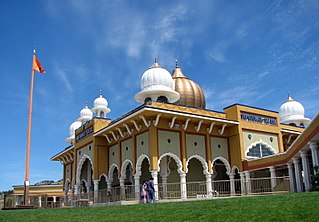
American Sikhs form the country's sixth-largest religious group. While the U.S. Census does not ask about religion, 70,697 Americans declared Sikh as their ethnicity in the 2020 census. The U.S. Census Bureau cites the 2008 American Religious Identification Survey's estimate of the adult Sikh American population at 78,000. The Pew Research Center estimated the Sikh American adult population to be 140,000 and the total population at 200,000 in 2012 while the World Religion Database at Boston University estimated the American Sikh population to be at 280,000 in 2012. Sikh organizations like the Sikh Coalition and American Sikh Congressional Caucus estimate the Sikh American population to be as high as 1,000,000, but do not provide any sources for these figures; 500,000 nevertheless remains the most cited Sikh American population size. With 1% of Asian Americans being Sikh, and 90.7% of Sikh Americans being Asian American, the American Sikh population can be estimated at around 200,000–300,000 in 2021. The largest Sikh populations in the U.S. are found in California (52%), New York (11%), and Washington (6%).
Sikh practices are guidelines laid out by the Gurus for the practice of the "Sikh way of life". The Gurus emphasise that a Sikh should lead a disciplined life engaged in Naam Simran, meditation on God's name, Kirat Karo, living an honest life of a house-holder, and Vand Chaako, sharing what one has with the community. This translates into hard work, honest living, love of fellow humans and through them service of the God, the primal power. This way of life is said to have been stripped of complications, myths, jargon, rituals and exploitation of man by man in the name of religion. No benefits are gained by where and to which family the person is born to – All have to undertake the rigours of Simran (meditation) and Sevā to progress spiritually. The Guru Granth Sahib asks the Sikh to "Practice truth, contentment and kindness.

Sikhismin Canada has nearly 800,000 adherents who account for 2.1% of Canada's population as of 2021, forming the country's fastest-growing and fourth-largest religious group. The largest Sikh populations in Canada are found in Ontario, followed by British Columbia and Alberta. As of the 2021 Census, more than half of Canada's Sikhs can be found in one of four cities: Brampton (163,260), Surrey (154,415), Calgary (49,465), and Edmonton (41,385).
Sikhism is a minority religion in Belgium, but Sikhs have played a role in Belgian history; during World War I, many Sikhs fought in Belgium. In the First Battle of Ypres, an entire platoon of Dogra Sikhs died.

Aviapolis is a business, retail, entertainment, and housing marketing brand area in central Vantaa, Finland, covering roughly 40 square kilometres (15 sq mi), including Finland's main airline hub and airport, Helsinki Airport.

World Sikh Organization (WSO) is a Sikh religious and non-profit organization whose 1984 founding goal was "to provide an effective, credible voice to represent Sikh interests on the world stage", after Operation Blue Star. Its stated goal is "to promote and protect the interests of the Sikh Diaspora", and "promote and advocate for" human rights. Tejinder Singh Sidhu currently serves as President of the organization.
Sikhism was founded in Punjab in 1469 by Guru Nanak on the foundations that everyone is equal, regardless of caste, age, or gender. Both men and women are supposed to follow the Five Ks: Kesh, Kangha (comb), Kara, Kachera and Kirpan, and there was never a distinction between what a woman should be allowed to do versus a man at theological level. Men and women are treated equally in the temple (gurdwara), and everyone eats and prays side-by-side. Both men and women are meant to carry the Kirpan with them as they are responsible for their own physical protection, and should not depend on others. Sikhs are strictly against the caste system and many chose to use Kaur or Singh as a last name to push against the problematic caste system in India. There is only one god (Waheguru) in Sikhism and they are without form or gender, and everyone is equal in the eyes of God. Many Sikh women believe that this absence of assignment of code of conduct for a woman versus a man proves that their religion is historically committed to gender equality. Presently, the culture does not always follow these traditions and equality is often more true in ideals rather than daily practice. According to Kiman Kaur: "It is essential to take into account the diverse Kaur narratives in order to critically understand the violence Sikh women experience due to religious, ethnic, and gender minoritization through enabling more intersectional conversations."
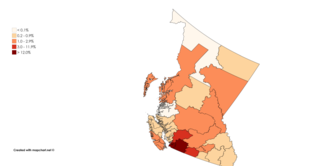
The South Asian community in British Columbia was first established in 1897. The first immigrants originated from Punjab, British India, a northern region and state in modern-day India and Pakistan. Punjabis originally settled in rural British Columbia at the turn of the twentieth century, working in the forestry and agricultural industries.

Sikhism in Greater Vancouver is one of the main religions across the region, especially among the Indo-Canadian population. The Sikh community in Vancouver is the oldest, largest and most influential across Canada, having begun in the late 19th century.

Sikhism in Poland dates back mostly to the 1990s or early 2000s, during the immigration of Indians to Poland. There are about approximately 1000 Sikhs in Poland, with the vast majority of them living in the capital of Warsaw.

Local and regional bus services are a large part of public transport in the Helsinki region. HSL bus services include internal services in Helsinki, Espoo, Kauniainen, Vantaa, Kerava, Kirkkonummi, Sipoo, Siuntio and Tuusula and regional services between them.

Sikhs in Spain are a minority religion group. The Sikh community in Spain is a small but fast growing group. According to the latest available data, there are estimated to be around 26,000 Sikhs living in the country. The Sikh population in Spain has grown over the years, with many Sikhs migrating to the country for agricultural work, construction work or to start their own businesses.



















